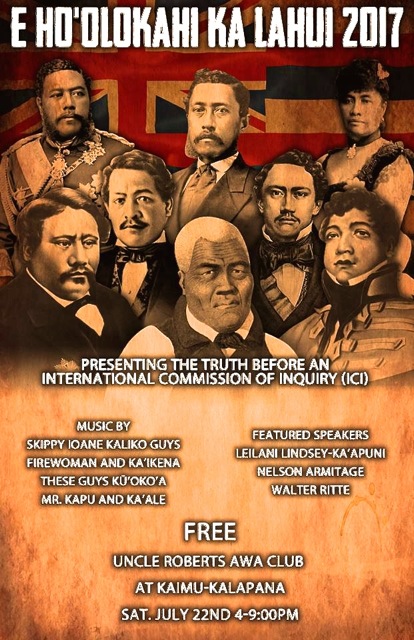
Ho‘olokahi Event at Kalapana
Reply



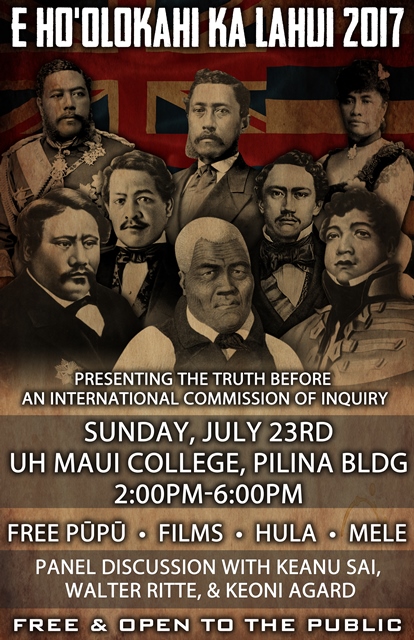
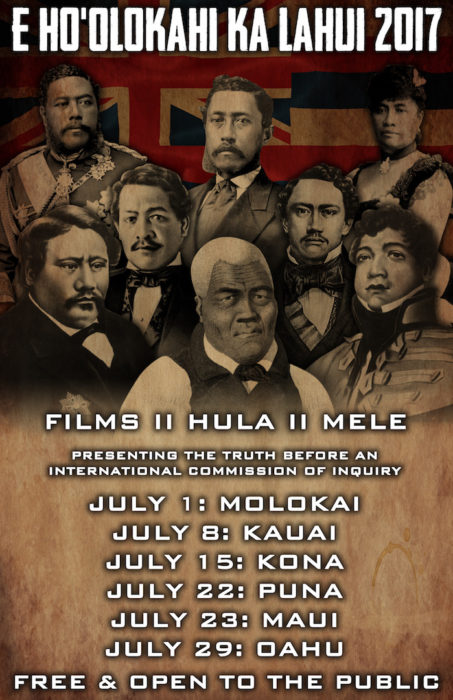

From June 25 through July 5, 2017, the National Education Association (NEA) held its Annual Meeting and Representative Assembly in Boston, Massachusetts. The NEA is the largest labor union of 3 million members who work at every level of education that span from pre-school to university graduate programs. Formed in 1857, the NEA’s “mission is to advocate for education professionals and to unite our members and the nation to fulfill the promise of public education to prepare every student to succeed in a diverse and interdependent world.” Members include public school teachers, educational support professionals, higher education faculty and staff, and school administrators.
 The Hawai‘i State Teachers Association (HSTA) is an affiliate union of the NEA whose members come from the public schools throughout Hawai‘i. Its Secretary/Treasurer, Amy Perruso, a teacher from Mililani High School was one of the first teachers to begin teaching about the illegal overthrow of the government of the Hawaiian Kingdom and the illegal American occupation that followed. The textbook that she uses is Ua Mau Ke Ea—Sovereignty Endures: An Overview of the Political and Legal History of the Hawaiian Islands by Dr. Keanu Sai.
The Hawai‘i State Teachers Association (HSTA) is an affiliate union of the NEA whose members come from the public schools throughout Hawai‘i. Its Secretary/Treasurer, Amy Perruso, a teacher from Mililani High School was one of the first teachers to begin teaching about the illegal overthrow of the government of the Hawaiian Kingdom and the illegal American occupation that followed. The textbook that she uses is Ua Mau Ke Ea—Sovereignty Endures: An Overview of the Political and Legal History of the Hawaiian Islands by Dr. Keanu Sai.
Perruso teaches Pre-AP Modern Hawaiian History/Participation in Democracy, AP U.S. History and A.P. Government and Politics. Commenting on the textbook Ua Mau Kea Ea, she stated, “Secondary educators in Hawai‘i are extremely fortunate to be able to access the rarest of pedagogical materials for the required Hawai‘i DOE Modern Hawaiian History course: an academically sound and well-written textbook.”
When the United States was celebrating its independence as a country on the 4th of July, the NEA’s Annual Meeting and Representative Assembly convened and for 90 minutes they took up New Business. On the agenda was New Business Item 37 introduced by the HSTA Representatives, which stated:
“The NEA will publish an article that documents the illegal overthrow of the Hawaiian Monarchy in 1893, the prolonged occupation of the United States in the Hawaiian Kingdom and the harmful effects that this occupation has had on the Hawaiian people and resources of the land.”
According to the HSTA Facebook, Chris Santomauro, a teacher at Kane‘ohe Elementary introduced the proposal, and Uluhani Wai‘ale‘ale, a teacher at Kualapu‘u Charter School on Moloka‘i gave an impassioned and articulate argument in favor of the proposal and it swayed a majority of teachers from across the United States to support it.
Congratulations!
There are certain standards that need to be met with regard to the terms “indigenous sovereignty” and “state sovereignty” and it begins with definitions. The former applies to indigenous peoples, while the latter applies to independent States. Current usage in Hawaiian discourse tends to conflate the two terms as if they are synonymous. This is a grave mistake that only adds to the already confusing discourse of sovereignty talk amongst Hawai‘i’s population. Instead of beginning with the definition of the terms and their difference, there is a tendency to argue native Hawaiians are an indigenous people as if it is a forgone conclusion.
Indigenous studies make a clear distinction between the terms. Corntassel and Primeau’s article “Indigenous ‘Sovereignty’ and International Law: Revised Strategies for Pursuing ‘Self-Determination,” Human Rights Quarterly 17.2 (1995) 343-365), refers to indigenous people as a “stateless group in the international system.” Defining a stateless group, Corntassel and Primeau cite Milton J. Esman’s article, “Ethnic Pluralism and International Relations,” Canadian Review of Studies in Nationalism 27 (1990): 88, where he defines non-state nations as ethnic groups that do not have a patron State of their own.
While the State has its origins that date back to 1648—Treaty of Westphalia, it wasn’t until 1982 that the United Nations officially recognized indigenous groups when it formed the UN Working Group on Indigenous Populations. That year the Working Group came up with its definition of indigenous populations. “Indigenous populations are composed of the existing descendants of the peoples who inhabited the present territory of a country wholly or partially at the time when persons of a different culture or ethnic origin arrived there from other parts of the world, overcame them, and, by conquest, settlement or other means reduced them to a non-dominant or colonial condition; who today live more in conformity with the particular social, economic and cultural customs and traditions that with the institutions of the country of which they now form part, under a State structure which incorporates mainly the national, social and cultural characteristics of other segments of the population which are predominant.”
According to Corntassel and Primeau the Working Group’s definition was so broad that “any non-state nation … could fit under the term ‘indigenous population (p. 347),’” which would go outside the Working Group’s focus on tribal populations. They argue that under such a broad definition any people that are non-States such as Basques, Kurds, Abkazians, Bretons, Chechens, Tibetans, Timorese, Puerto Ricans, Northern Irish, Welsh, Tamils, Madan Arabs, or Palestinians could identify themselves as “indigenous people (p. 348).”
Seven years later, in a move to limit the definition to tribes, the term “tribal peoples” was inserted in Article 1 of the 1989 Convention concerning Indigenous and Tribal Peoples in Independent Countries, No. 169, adopted by the International Labor Organization. Article 1, provides: “(a) tribal peoples in independent countries [States] whose social, cultural and economic conditions distinguish them from other sections of the national community, and whose status is regulated wholly or partially by their own customs or traditions or by special laws or regulations; (b) peoples in independent countries [States] who are regarded as indigenous on account of their descent from the populations which inhabited the country, or a geographical region to which the country belongs, at the time of conquest or colonisation or the establishment of present state boundaries and who, irrespective of their legal status, retain some or all of their own social, economic, cultural and political institutions.”
An “independent country” is an independent State that is a self-governing entity possessing absolute and independent legal and political authority over its territory to the exclusion of other States. All members of the United Nations are independent States. The ILO was clearly distinguishing between indigenous tribal peoples and the States they reside in. The 2007 United Nations Declaration on the Rights of Indigenous Peoples also makes that distinction in Articles 5, 8(2), 11(2), 12(2), 13(2), 14(2) (3), 15(2), 16(2), 17(2), 19, 21(2), 22(2), 24(2), 26(3), 27, 29, 30(1) (2), 32(2) (3), 33(1), 36(2), 37(1), 38, 39, 40, 42, and 46(1).
The ILO Convention covered the “what” are indigenous populations, being “tribal peoples in independent countries [States],” but it did not satisfactorily determine the “who.” This was somewhat addressed by Jose R. Martinez Cobo, Special Rapporteur of the Sub-Commission on Prevention of Discrimination and Protection of Minorities, in his 1986 Report on the Study on the Problem of Discrimination against Indigenous Populations, which stated:
“Indigenous communities, peoples and nations are those which, having a historical continuity with pre-invasion and pre-colonial societies that developed on their territories, consider themselves distinct from other sectors of the societies now prevailing on those territories, or parts of them. They form at present non-dominant sectors of society and are determined to preserve, develop and transmit to future generations their ancestral territories, and their ethnic identity, as the basis of their continued existence as peoples, in accordance with their own cultural patterns, social institutions and legal system (paragraph 379).”
“This historical continuity may consist of the continuation, for an extended period reaching into the present of one or more of the following factors: (a) Occupation of ancestral lands, or at least of part of them; (b) Common ancestry with the original occupants of these lands; (c) Culture in general, or in specific manifestations (such as religion, living under a tribal system, membership of an indigenous community, dress, means of livelihood, lifestyle, etc.); (e) Language (whether used as the only language, as mother-tongue, as the habitual means of communication at home or in the family, or as the main, preferred, habitual, general or normal language); (f) Residence on certain parts of the country, or in certain regions of the world; (g) Other relevant factors (paragraph 380).”
“On an individual basis, an indigenous person is one who belongs to these indigenous populations through self-identification as indigenous (group consciousness) and is recognized and accepted by these populations as one of its members (acceptance by the group) (paragraph 381).”
Throughout his report, Cobo also distinguishes between indigenous populations and the States they reside. On this note, Cobo recommends:
“States should seek to gear their policies to the wish of indigenous populations to be considered different, as well as to the ethnic identity explicitly defined by such populations. In the view of the Special Rapporteur, this should be done within a context of socio-cultural and political pluralism which affords such populations the necessary degree of autonomy, self-determination and self-management commensurate with the concepts of ethnic development (paragraph 400).”
“Countries with indigenous populations should review periodically their administrative measures for the formulation and implementation of indigenous population policy, taking particular account of the changing needs of such communities, their points of view and the administrative approaches which have met with success in countries where similar situations obtain (paragraph 404).”
In the 1996 Report of the Working Group (paragraph 31), representatives of the indigenous populations stated, “We, the Indigenous Peoples present at the Indigenous Peoples Preparatory Meeting on Saturday, 27 July 1996, at the World Council of Churches, have reached a consensus on the issue of defining Indigenous Peoples and have unanimously endorsed Sub-Commission resolution 1995/32. We categorically reject any attempts that Governments define Indigenous Peoples. We further endorse the Martinez Cobo report (E/CN.4/Sub.2/1986/Add.4) in regard to the concept of “indigenous.” The 2007 Declaration on the Rights of Indigenous Peoples does not provide for a different definition of indigenous peoples, but rather declares their rights within the States they reside.
In 2001, the Permanent Court of Arbitration, in Larsen v. Hawaiian Kingdom, concluded, that “in the nineteenth century the Hawaiian Kingdom existed as an independent State recognized as such by the United States of America, the United Kingdom and various other States, including by exchanges of diplomatic or consular representatives and the conclusion of treaties.” There are no indigenous people in the Hawaiian Islands because the aboriginal Hawaiians formed the State themselves, comparable to other Polynesians who formed their own States such as Samoa in 1962, and Tonga in 1970. Both States are members of the United Nations. The only difference, however, was that Hawai‘i was the first of the Polynesians to be recognized as an independent State. Furthermore, Samoans and Tongans do not refer to themselves as an “indigenous people,” but rather the citizenry of two independent States.
This is why it is paradoxical to say that natives of Hawai‘i (kanaka) are an indigenous people because it would imply they do not have a State of their own. This labeling of Hawaiian natives as indigenous people is an American narrative that has no basis in historical facts or law other than people just saying it. Rather, natives are the majority of Hawaiian subjects, being the citizenry of the Hawaiian Kingdom that has been in an unjust war by the United States since 1893.
MEDIA RELEASE
SCOTT FOSTER
Phone & Text 808-590-5880
THE THEFT OF A NATION
La Ho`iho`i Ea presents a Dramatic Re-enactment
10 am July 4, 2017, ʻIolani Palace Front Steps
HONOLULU: JUNE 29, 2017 — Americans celebrate American Independence Day on the Fourth of July every year, commemorating the Declaration of Independence and the birth of the United States of America as an independent nation in 1776. To mark an event from Hawai’i’s history, La Hoʻihoʻi Ea <http://lahoihoiea.org/history/> will observe this Fourth of July with a dramatic re-enactment of events that occurred over a century ago at ‘Iolani Palace.
Beginning at 10:00 am July 4, 2017, on the front steps of ʻIolani Palace, La Hoʻihoʻi Ea will present a dramatic re-enactment of the events that led to proclaiming into existence of the Republic of Hawaii and the subsequent installation of Sanford B. Dole as President of the Territory of Hawaii. “With Bible in hand, pistols in their pockets and American Naval troops at the ready, men gathered on the steps of ʻIolani Palace on July 4th, 1894. Invoking the name of American liberty, they dismantled the liberty of the people of the Hawaiian Kingdom.”
This exciting re-enactment is free and open to the public. The script, a work in progress, has been prepared using input from several noted Hawai`i scholars and historians including writer/producer Tom Coffman <http://hawaiibookandmusicfestival.com/tom-coffman/>, Poka Laenui of Moʻoaupuni <https://mooaupuni.org/> and Dr. Lynette Cruz of La Ho`iho`i Ea. The “work in progress” event is being staged by MarshaRose Joyner. The four have worked together since 1989 under the banner of Sacred Times and Sacred Places.
CAST OF CHARACTERS
NARRATORS
Poka Laenui
Tom Coffman
THE HISTORY
On January 16, 1893, United States diplomatic and military personnel conspired with a small group of individuals to overthrow the constitutional government of the Hawaiian Kingdom and prepared to provide for annexation of the Hawaiian Islands to the United States of America under a treaty of annexation submitted to the United States Senate on February 15, 1893. Newly elected U.S. President Grover Cleveland, having received notice that the cause of the so-called revolution derived from illegal intervention by U.S. diplomatic and military personnel withdrew the treaty of annexation and appointed James H. Blount, as Special Commissioner, to investigate the terms of the so-called revolution and to report his findings.
The report concluded that the United States legation assigned to the Hawaiian Kingdom, together with United States Marines and Navy personnel, were directly responsible for the illegal overthrow of the Hawaiian Kingdom government. The report detaild the culpability of the United States government in violating international laws and the sovereignty of the Hawaiian Kingdom, but the United States Government failed to follow through in its commitment to assist in reinstating the constitutional government of the Hawaiian Kingdom.
Instead, the United States allowed five years to elapse. A new United States President, William McKinley, entered into negotiations for a second treaty of annexation on June 16, 1897, with the same individuals who participated in the illegal overthrow in 1893, but the treaty failed to be ratified by the United States Senate due to protests submitted by Her Majesty Queen Lili‘uokalani and signature petitions opposing annexation signed by 21,169 Hawaiian nationals.
As a result of the Spanish-American War, the United States opted to unilaterally take the Hawaiian Islands by enacting a Congressional joint resolution on July 7, 1898, in order to utilize the Hawaiian Islands as a military base to fight the Spanish in Guam and the Philippines. The United States has remained in the Hawaiian Islands and the Hawaiian Kingdom has since been under prolonged occupation to the present, but its continuity as an independent State remains intact under international law.
Two separate camps divided Hawaiʻi’s political environment. One, a small minority, held the power of government through the landing of the U.S. military. The second, Hawaiian loyalists, supported their Hawaiian Queen Liliuokalani and their country.
The first camp wanted annexation of Hawaiʻi to the U.S., part of a larger plan to open their sugar exports to U.S. markets. They sided with American expansionists like John L. Stevens, U.S. Minister to Hawaiʻi. Hawaiian subjects, according to U.S. special investigator James Blount, were almost to the man in opposition to annexation.
U.S. troops landed on January 16, 1893 and supported a self-proclaimed “provisional government” the next day. A hurriedly drafted annexation treaty was sent to the U.S. Senate in February for ratification under Harrison’s administration, but that treaty failed. Grover Cleveland, inaugurated President in March, sent Blount to investigate the Hawaiian affair. Having received Blount’s report, Cleveland railed against U.S. conspiracy and withdrew the treaty in December.
Sanford Dole, President of the “provisional” government, was criticized for the lack of legitimacy. He convened a convention of 37 delegates, 19 appointed by him, the remainder elected by those who disavowed loyalty to Queen Liliʻuokalani and who swore allegiance to the provisional government.
Using as their backdrop the U.S. Independence day celebration, Dole’s group assembled at ʻIolani Palace at 8:00 A.M., July 4, 1894. With guns tucked out of public sight, William O. Smith, one of the early conspirators of the group, acted as master of ceremony. Dispensing with the opening prayer, apparently skittish over the proceedings taking place, Smith introduced Dole. Dole, looking down upon their members, proclaimed “the Republic of Hawaiʻi as the sovereign authority over and throughout the Hawaiian Islands.” He went on, “And I declare the Constitution framed and adopted by the Constitutional Convention of 1894 to be the constitution and the supreme law of the Republic of Hawaiʻi, and by virtue of this constitution I now assume the office and authority of president thereof.”
The constitution declared all Liliʻuokalani’s government’s lands, waters and citizens as those of the Republic.
While framing their activities around the American principle that the right of governance can only be achieved through the consent of the governed, the Republic of Hawaiʻi was declared in just the opposite manner. No ratification or consent was given the Republic by Hawaiians.
At a party in Honolulu at the U.S. Legation to celebrate July 4th that evening, Kahuku Plantation founder, J.B. Castle, proclaimed, “Americans assemble here today amidst novel and serious events to make a new declaration of independence and of principles, broader and wiser than the declaration of 1776; to make the solemn declaration that the intelligent minority in every community has the inalienable right to good government, which they are justified in securing, holding themselves responsible only to God and their own consciences for the just and proper use of power in their hands.”
Castle continued: “The inexorable law of evolution withdraws the native from his long dominance, and forces the American and his allies to the front, with a demand for a new declaration of principles. . . . the Anglo Saxon and his allies, with the best thought of civilization behind them, and trained in the best use of political machinery . . . may demonstrate to the world that they can hold the supreme power, at first, for the good of all, and gradually educate, and lead the men of other races up to their own standards of good government, and finally and safely, distribute that power among all races. . .” “We solemnly declare, with the experience of a hundred years behind us, that minorities in number have the inalienable right to good government, and they are commissioned to secure and maintain it, holding themselves responsible to God and their own consciences, for the just and proper use of the power organized and used to obtain it.” Source: Pacific Commercial Advertiser, July 5, 1894, Honolulu, Hawai`i.

Proceedings to establish an International Commission of Inquiry under Part III of the 1907 Hague Convention for the Pacific Settlement of International Disputes stemming from the Larsen v. Hawaiian Kingdom arbitration held under the auspices of the Permanent Court of Arbitration (1999-2001) were initiated under a Special Agreement dated January 19, 2017. The title for these proceedings is “Incidents of War Crimes in the Hawaiian Islands—The Larsen Case.”
On March 3, 2017, Professor Francesco Francioni was designated by the parties by a supplemental agreement to be the appointing authority, whose function is to form the International Commission of Inquiry. Professor Francioni is an ad hoc judge on the International Tribunal for the Law of the Sea as well as serving as one of five arbitrators in a dispute under the auspices of the Permanent Court of Arbitration, The “Enrica Lexie” Case (Italy v. India). The parties notified the appointing authority that the prospective commissioners shall not United States citizens; must have command of the English language; have expertise in international humanitarian law; and include, at least, one woman.
Article I of the Special Agreement was amended by the parties on March 26, 2017 to allow the Commission to designate a Secretary General to serve as a registry, and for the President of the Commission to work with the Secretary General in order to determine a location for the sitting of the Commission. The only stipulation by the parties is that the sitting shall be in Europe.
Warning: This comedy video does contain vulgar language.
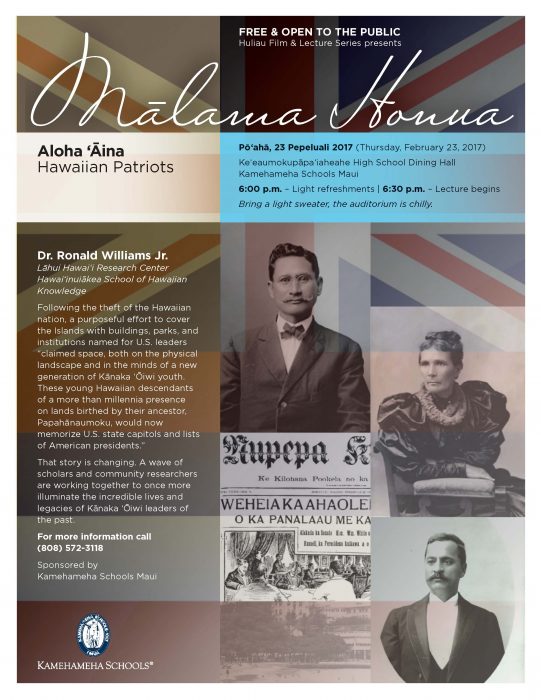
https://vimeo.com/202258766
Dr. Lynette Cruz, host of “Issues that Matter,” interviews Dr. Federico Lenzerini, Professor of International law from the University of Siena Law Department, Italy, and Dr. Keanu Sai, political scientist and lecturer at the University of Hawai‘i, on the topic of proceedings that have been initiated at the Permanent Court of Arbitration stemming from the Larsen v. Hawaiian Kingdom arbitration case.
Dr. Sai, as Agent, and Dr. Lenzerini, as Counsel and Advocate, represent the Hawaiian Kingdom in these proceedings.

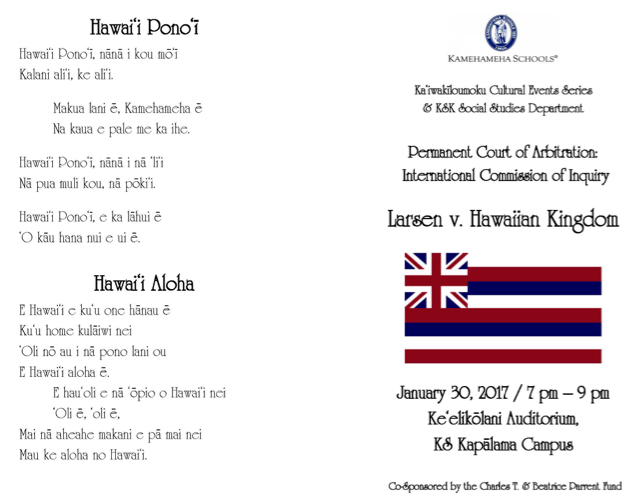
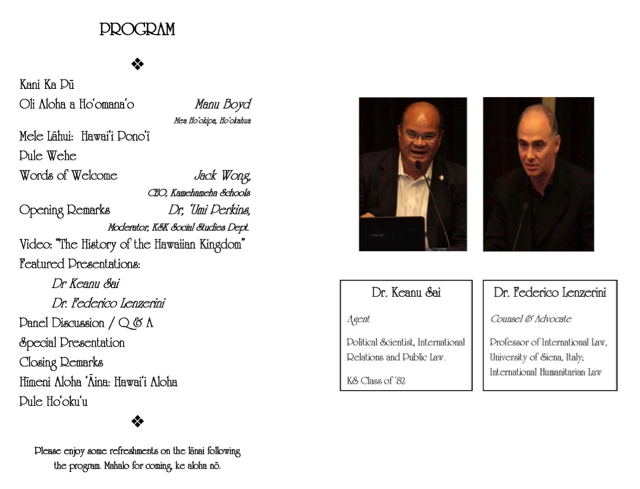
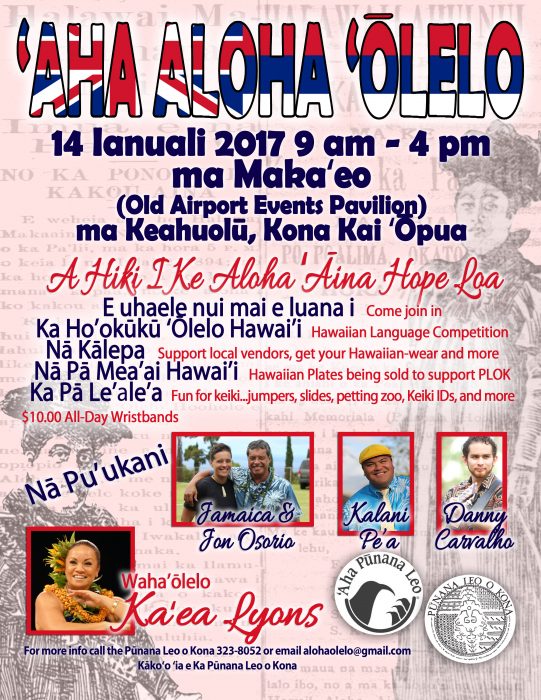
Pūnana Leo o Kona presents the 4th annual ʻAha Aloha ʻŌlelo on January 14, 2017 from 9:00am to 4:00pm at Makaʻeo (Old Airport Pavilion). ʻAha Aloha ʻŌlelo is an event for the entire ʻohana featuring live entertainment by Danny Carvalho, Kalani Peʻa, Duncan Kamakana Osorio, Jon Osorio and Jamaica Osorio. The event will also feature vendors, Hawaiian food and a Keikiland with bouncers, games and a petting zoo. A Hawaiian language competition with well over 100 competitors from schools such as Pūnana Leo o Kona, ʻEhunuikaimalino, Nāwahīokalaniʻōpuʻu and Pūnana Leo o Waiʻanae from Waiʻanae, Oʻahu will also be held. Tickets to the event are $10 or $12 at the door and keiki 10 and under are free.
The theme of this yearʻs Hawaiian language competition is built around a speech given on September 6, 1896 at a Hālāwai Makaʻāinana at Palace Square in Honolulu by James Keauiluna Kaulia, calling on the people of Hawaiʻi to “kūʻē loa aku i ka hoʻohui ʻia o Hawaiʻi me ʻAmelika a hiki i ke aloha ʻāina hope loa!” Kaulia was the President of the Hui Aloha ʻĀina, or Hawaiian Patriotic League when the question of annexing Hawaiʻi to the United States was before the U.S. government. Kaulia and others, including David Kalauokalani, Emma Nāwahī and Kuaihelani Campbell, led a petition drive protesting the annexation of Hawaiʻi to the United States of America. They sent out delegates to each island and all of its communities and through their collective efforts, over 37,000 signatures were gathered during a time in Hawaiian history where there were only about 40,000 Native Hawaiians alive.
After the gathering of the signatures, Kaulia and Kalauokalani, along with John Richardson and William Auld, traveled to Washington D.C. to deliver the anti-annexation petitions. Upon arriving to D.C., it was known that there were already 58 votes in U.S Congress for annexation, with only two more votes being needed to ratify the treaty presented to congress by the unlawful Republic of Hawaiʻi under Sanford Dole. The Commission was able to meet with many different Senators and Congressmen and they were able to have the annexation petitions read to the Senate and formally accepted. By the time the Commission left Washington D.C. to return back to Hawaiʻi, there were only 46 votes in the Senate for annexation, far below the 60 votes required to ratify the treaty. The treaty of annexation was dead. Hawaiʻi remained an independent country, as it has been since November 28, 1843, albeit under an illegal, unlawful and self-proclaimed government.
“These petitions show us the potential of our Lāhui. Our kūpuna were actively engaged in the political issues surrounding them and their country. We are in a point of history where we face very similar issues,” said Kahoʻokahi Kanuha, the organizer of the Hawaiian language competition. “I am hopeful that this competition and event will remind us of the inherited kuleana we have to this ʻāina. These petitions show us who we were, who we are and most importantly who we still must be.”
###
For more information, e ʻoluʻolu, contact:
Kahoʻokahi Kanuha
808-936-4249
kahookahi@ahapunanaleo.org
Facebook: ʻAha Aloha ʻŌlelo
Instagram: @alohaolelo
Twitter: @alohaolelo